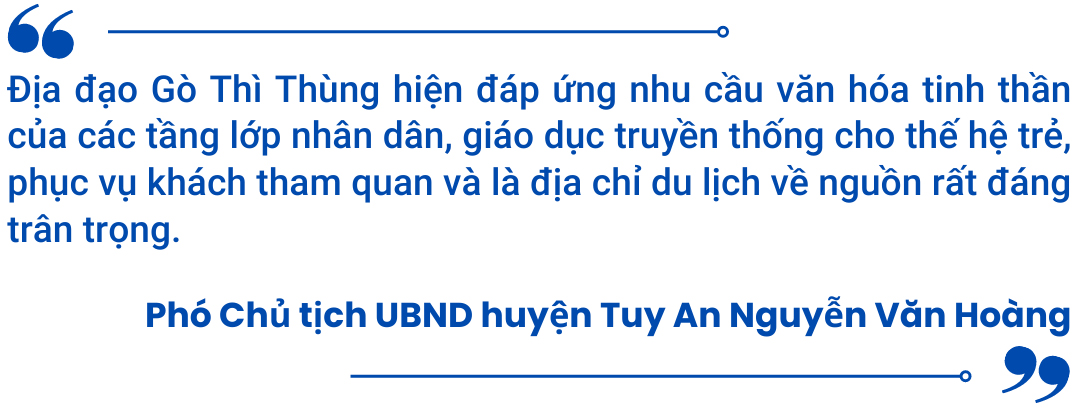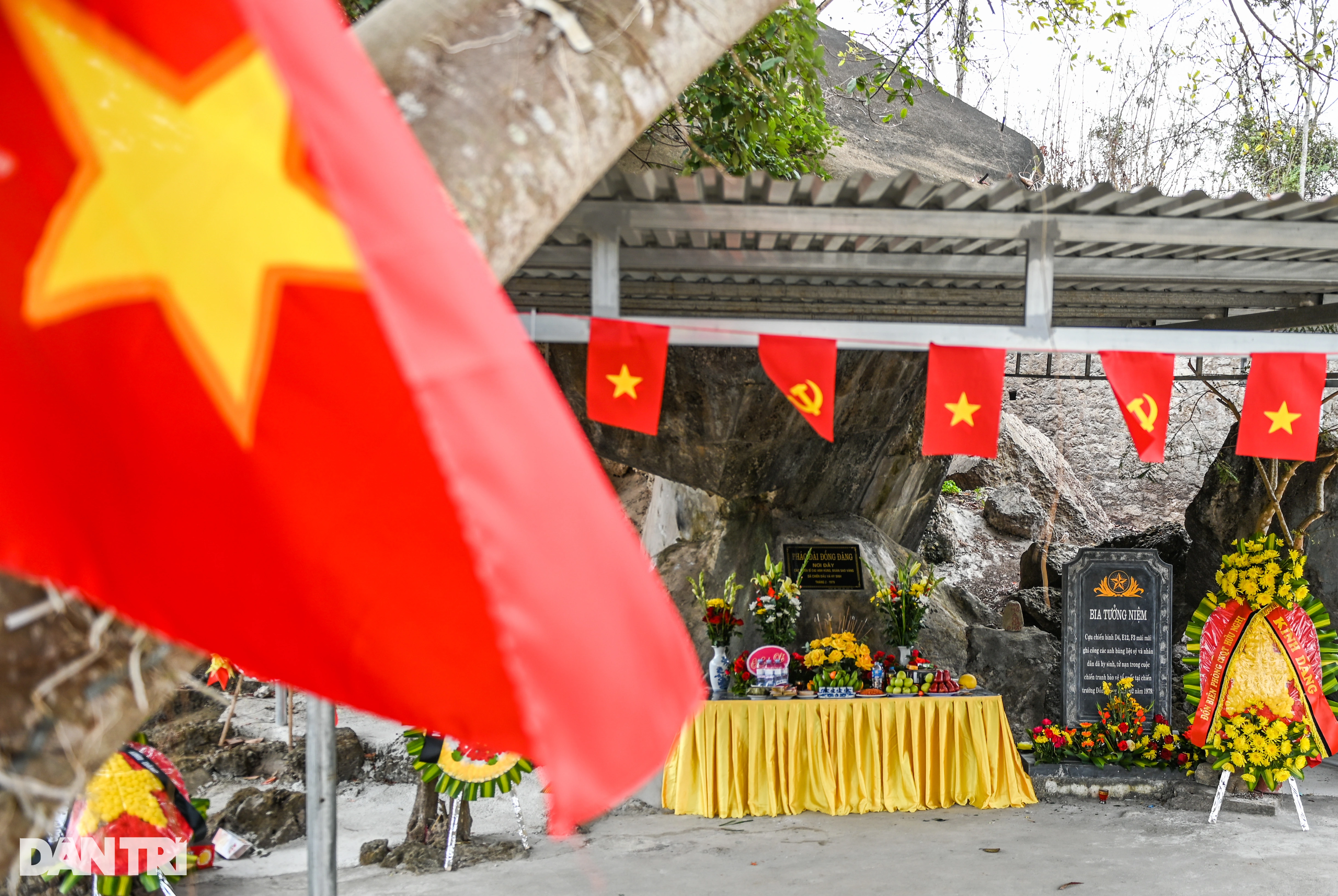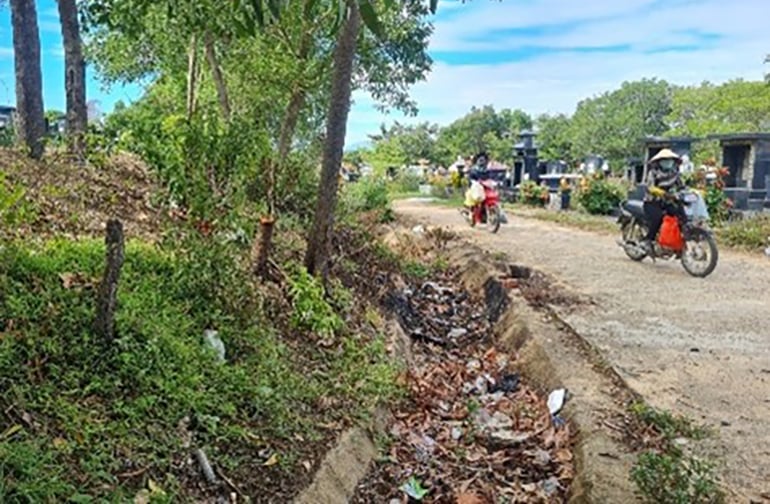Go Thi Thung Tunnel (An Xuan Commune, Tuy An District) is a strategic military location, a solid base for local troops and militia to defeat many attacks by the US army, making resounding achievements. Today, this historical site is one of the attractive tourist destinations, the pride of the people of Phu Yen in general and Tuy An in particular.
 |
| The exhibition recreates the history of the resistance against the US to save the country at Go Thi Thung tunnel. Photo: PHAM THUY |
Revolutionary base
In September 1961, An Xuan commune was liberated and gradually consolidated and stabilized in all aspects, becoming a solid revolutionary base, linked with the provincial resistance base located in the three communes of Son Long, Son Dinh, and Son Xuan (Son Hoa district). However, the enemy still tried to conduct fierce sweeps with the support of modern means of war.
Faced with that situation, on April 22, 1964, the Tuy An Provincial Party Committee and District Party Committee held an extraordinary meeting to discuss measures to maintain the revolutionary base area and decided to dig a tunnel at Go Thi Thung. On May 10, 1964, the Go Thi Thung Tunnel project began. To avoid enemy detection, we dug the tunnel at night. The Tuy An District and Provincial Military Commands directly commanded the militia of An Xuan, An Dinh, and An Nghiep communes to dig the tunnel. After 15 months of hard work and sweat, the project was completed in August 1965. The Go Thi Thung Tunnel is about 400m above sea level, with a tunnel 1,948m long, 4.5m deep, 0.8m wide and 486 wells along with a system of command tunnels, food, weapons, and water reserves... that could withstand artillery shells and small bombs.
In addition to the main tunnel and underground branches, around the Go Thi Thung tunnel there are many layers of trenches connecting to each other and to the tunnel; along the trenches are arranged many combat fortifications. Between the layers of trenches in front and behind the tunnel, we planted low spikes to prevent infantry from marching and high stakes to prevent aircraft from landing and dropping troops. In addition, the tunnel is covered by a forest of wild sim flowers, above is a cool canopy of the forest. The green color of the forest trees kept the secret of the tunnel base, allowing our army and people to perform glorious feats.
The exploits from the tunnels
On April 10, 1966, the US used a battalion of the 1st Brigade, 101st Division to land by helicopter in An Xuan, An Linh to sweep and survey the terrain, preparing to set up an attack on our base area. On the morning of April 14, 1966, the enemy used many groups of bombers and artillery to fire heavily on the battlefield. From the fortifications, our forces quickly moved to the trenches to fight the enemy. In this battle, we destroyed 120 enemies and shot down 4 helicopters.
 |
On the morning of June 23, 1966, with the support of artillery and air force, the enemy used 40 helicopters to massively land troops in many places in An Nghiep, An Xuan, and An Linh communes. In the Song Trau mound area (region 1, An Xuan), we promptly launched a preemptive attack on the enemy helicopter landing site, killing 40 of them.
At 7:00 a.m. on June 24, 1966, a battalion of American soldiers from Song Trau hill divided into many wings and advanced to Thi Thung hill. The 11th Battalion of Ngo Quyen Regiment and the 7th Battalion of Tran Hung Dao Regiment set up positions at Thi Thung hill to fiercely block the American troops, killing dozens of them. The American troops used three artillery positions from Phu Tan, Xuan Phuoc, and Chi Thanh to fire continuously and drop heavy bombs on the tunnel, causing some sections to collapse. Every time the enemy concentrated their firepower on us, we retreated to the tunnel and waited for the enemy to get closer, then suddenly rushed forward and opened fire simultaneously. Many of the enemy died and had to retreat. At 2:00 p.m., the enemy landed 34 more helicopters at Dung hill, 500m northeast of Thi Thung hill, forming a new attack on our position. A company of the 7th Battalion of Tran Hung Dao Regiment set up at Dung hill immediately launched a preemptive attack as soon as the helicopter landed and dropped troops, killing dozens of them. On the night of June 24, 1966, under orders to end the war, the main force troops proactively withdrew from the tunnel to the designated location safely.
The victory in the battle on June 24, 1966 was also the greatest victory of our army and people associated with the Go Thi Thung tunnel. In this battle, the tunnel project brought into full play its function, both as a place to protect the command post, protect the fighting force, and protect the wounded throughout the war. After this battle, the Go Thi Thung tunnel was handed over to the An Xuan commune guerrilla force to continue managing and using it until the province was completely liberated.
 |
| Go Thi Thung horse racing festival attracts a large number of tourists. Photo: Contributor |
Attractive tourist destination
Tuy An is a land with great potential for tourism. The natural landscape system is diverse and unique with all forms, structures, and different terrain components. The history of the land has been built up over many centuries, the old residential areas, craft villages, and festivals create unique human and cultural values.
Currently, Tuy An is a locality with a high density of relics in the province with more than 50 relics of all kinds. Of which, there are 9 national relics, accounting for nearly half of the number of national relics in the whole province. Go Thi Thung tunnel is located in a high position, surrounded by many trees, the climate here is cool all year round. In 2009, Go Thi Thung tunnel was recognized by the Ministry of Culture, Sports and Tourism as a national historical relic and is one of the three largest tunnels in our country besides Cu Chi tunnel (Ho Chi Minh City) and Vinh Moc tunnel (Quang Tri).
This relic is 46km from Tuy Hoa city and 16km from Chi Thanh town (Tuy An district) by road. From Tuy Hoa city, follow National Highway 1 north 30km to Chi Thanh town, then turn left on DT641 route northwest 4km, continue to turn left on DT650 west 12km to reach Go Thi Thung tunnel.
According to Director of Tuy An District Culture - Sports and Broadcasting Center Bui Viet Huy, Go Thi Thung tunnels have many factors that create attraction for tourists that not every locality has. In addition to visiting the relic site to learn more about the heroic history of our army and people during the war with a national-scale tunnel system, visitors also have the opportunity to participate in the traditional horse racing festival held on the 9th day of the first lunar month every year; enjoy the cool feeling of the highland climate and enjoy many rustic dishes such as sour soup with dit leaves, wild vegetables, etc. In particular, the road to Go Thi Thung tunnels has been paved and extended from An Xuan commune to Uncle Ho's Church in Son Dinh commune (Son Hoa district), forming an attractive tourist route to the mountainous region.
 |
PHAM THUY
Source link























































Comment (0)